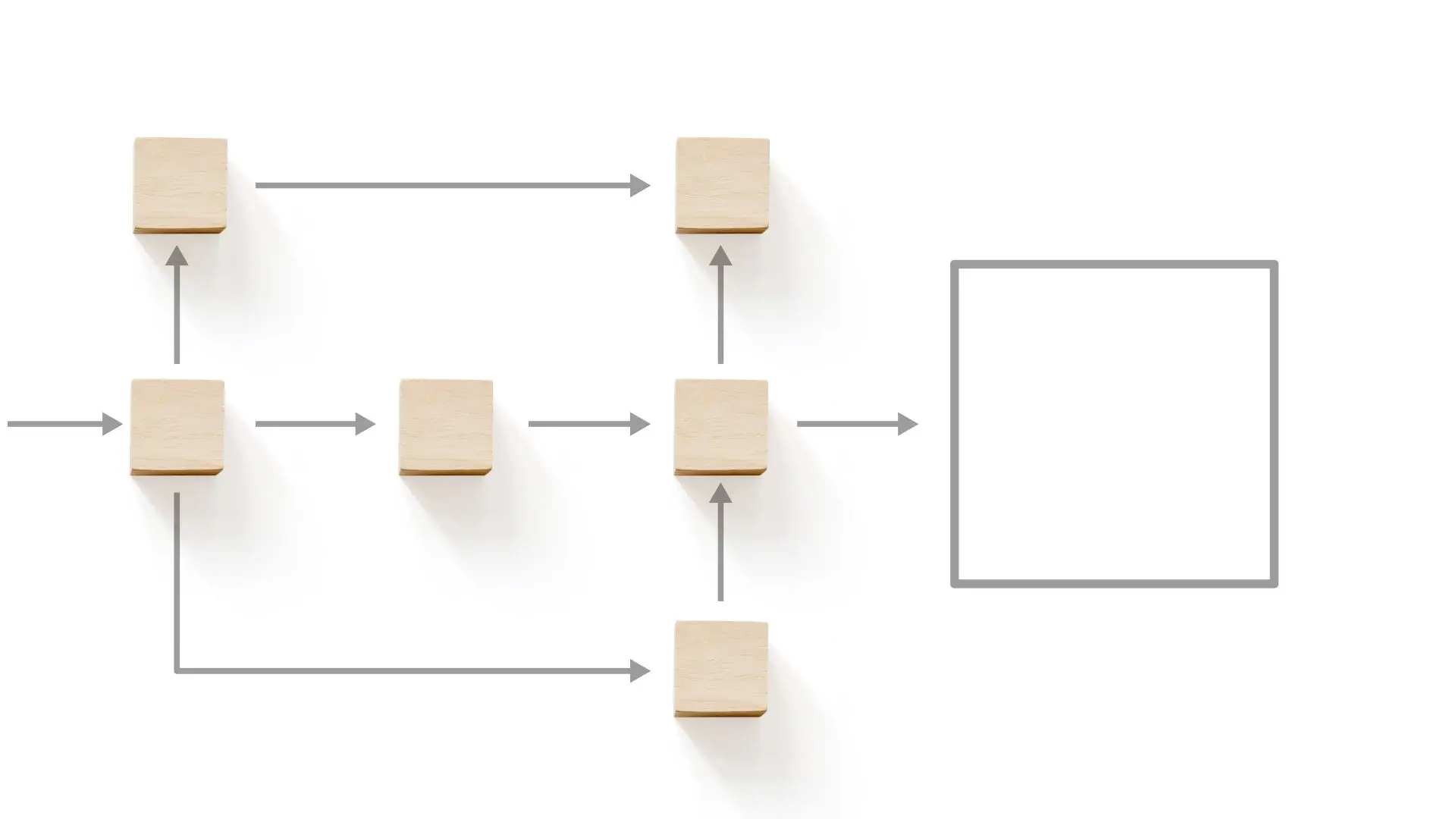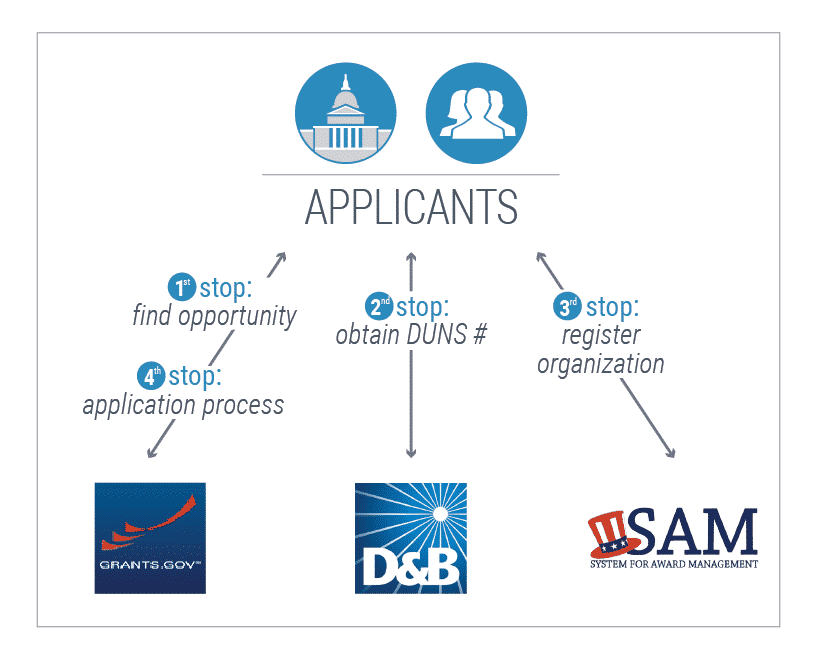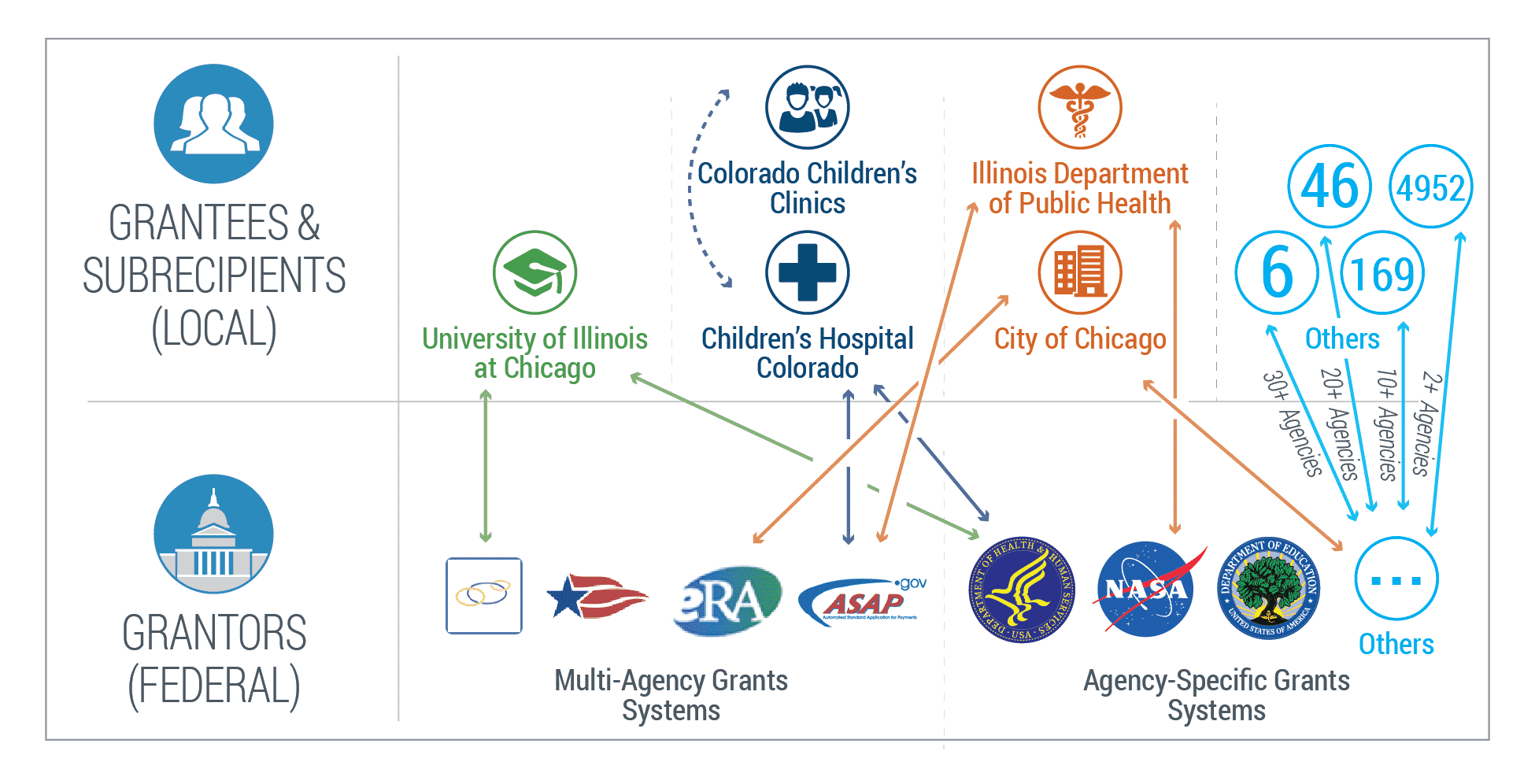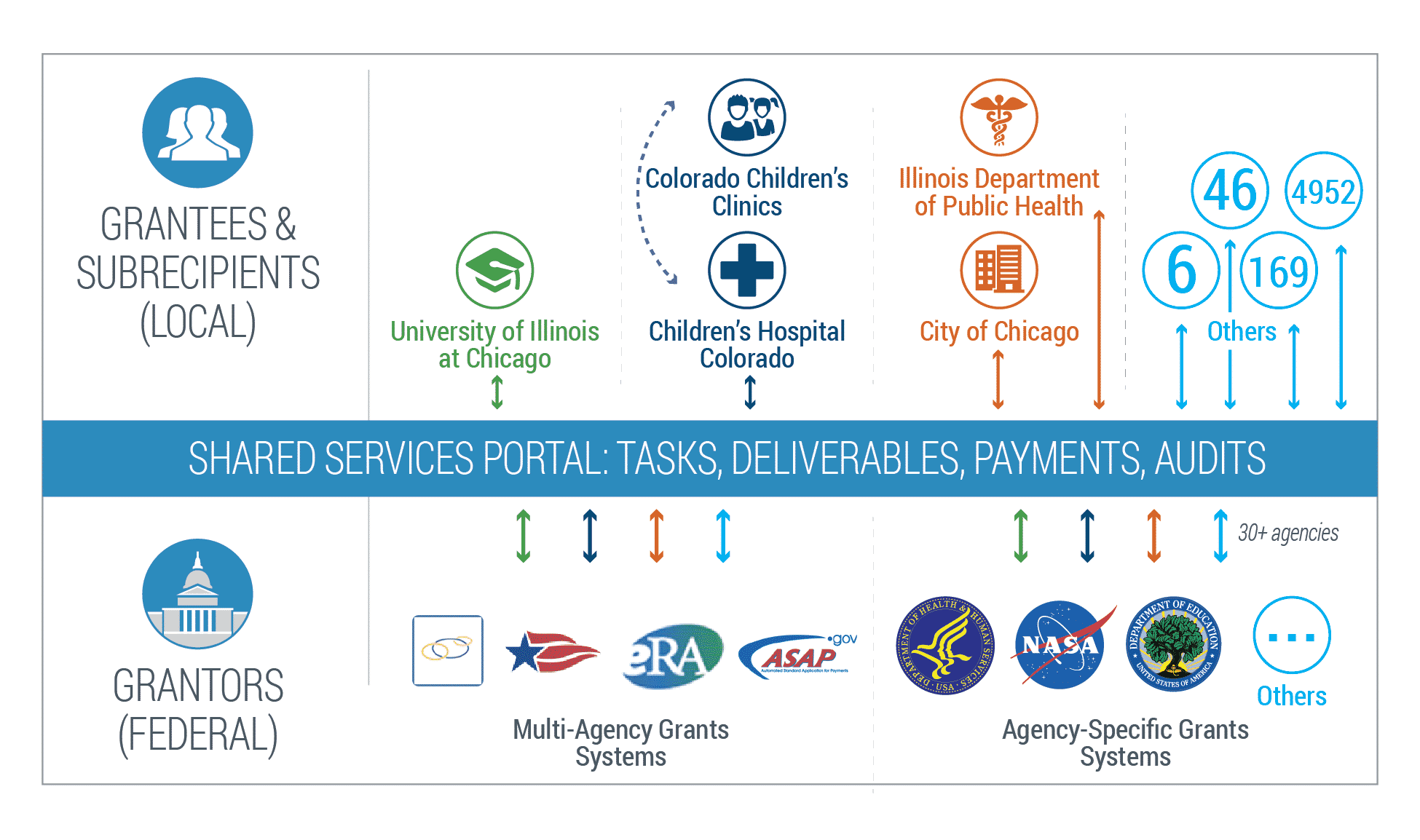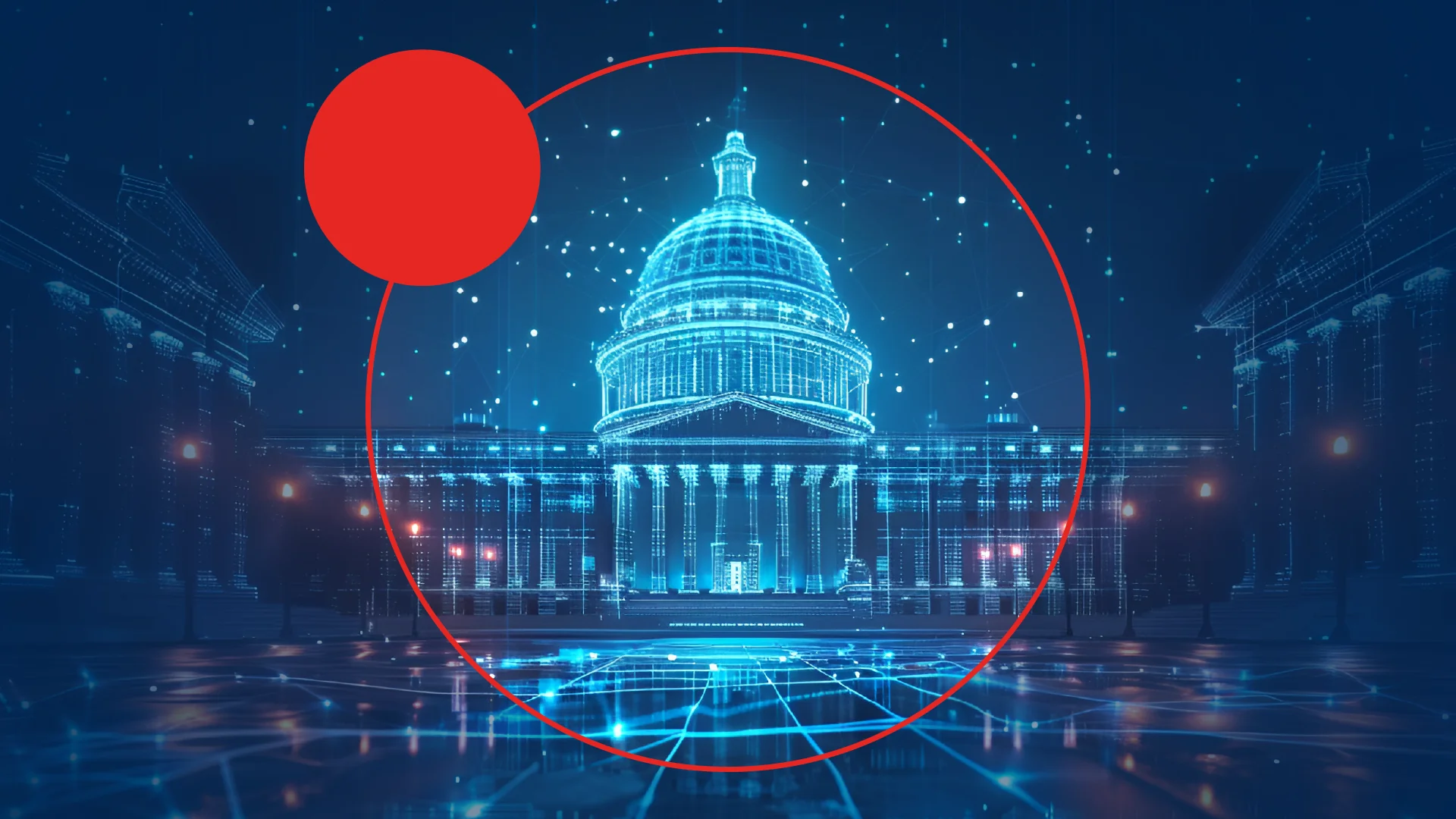Introduction
The Federal government provides millions of dollars each year in grants to run various public service programs and to stimulate the economy. In 2016, the Government awarded more than $650B to 31,000 grantees across 150 federal agencies. Each year hundreds of thousands of users from grantee organizations work collaboratively to apply for, receive an award, and meet the post-award requirements. Grants.gov has successfully consolidated and centralized initial applicant interactions with the government. But once the applications are received by the federal agencies, grantees must deal with a variety of systems during the award and post-award phases of the grants lifecycle.
Each year, more and more grant compliance and reporting work gets digitized. Thus, grantee users who receive awards from several agencies, must deal with multiple systems, remember separate usernames/ passwords, navigate different user interfaces, and struggle to remember what needs to be done and by when for their post-award commitments. The problems are compounded when there is staff turnover. The result is that frustrated grantees spend more time on low-value activities, not pursuing the purpose of their grants. On the government side, there is an opportunity to eliminate duplicative systems, strengthen security, and channel grantee oversight more toward high-value activities such as technical assistance instead of mere compliance.
In an article titled “5 Fixes for Grants Management,” REI Systems’ grants thought leader Subhash Kari proposed a Grants.gov-like “doorway” to simplify grantee interactions after they’ve received an award. This article expands on the concept of a single portal for post-award grantee interactions across the government. Improving grantee experience will ultimately lead to better mission outcomes because grantees will be more engaged and more satisfied.
What Works?
Grants.gov was created in 2002 for grant-making agencies to post discretionary opportunities and for applicant organizations to easily find opportunities and apply for grants through a single website. Federal agencies can market their grant programs to all target organizations through a single portal. Organizations that want to receive funds go through a set of processes defined by Grants.gov to apply for grants as shown in Figure 1. There are four main steps: 1) select funding opportunity, 2) obtain a DUNS number if the organization does not already have one, 3) register with System for Award Management website called SAM.gov to officially declare the intent to do business with the Federal government, and, 4) complete the application process via Grants.gov.
Figure 1. Pre-Award: Applicant organizations use a streamlined process to do business with the Federal government
Even though there are more than 150 grant-making agencies, applicants need to work with only three systems to get started: Grants.gov, Dun & Bradstreet (D&B), and SAM.gov. Thus, their experience in the pre-award journey is dramatically streamlined and consistent across the Federal government because it was designed from the user’s perspective. In FY 2016, Grants.gov served 4.8M unique users and processed 250K applications across 5,900 opportunities (Grants.gov Annual Report). Grants.gov eliminated the need for applicant organizations to learn different processes or to go to different locations for opportunities from different grant-making agencies.
What Doesn’t Work?
Nearly 15 years after Grants.gov was conceptualized, successful applicants or grantees have a completely different experience once they receive an award. To meet their post-award requirements and maintain funding levels, grantees and sub-recipients go to different systems depending on the grant-making agency as shown in Figure 2.
Figure 2. Post-Award: Recipients with grants from multiple agencies must deal with a myriad of systems each of which locally optimizes grantee journeys without realizing the burden they create across the Federal government
Many organizations receive funds from multiple agencies and must deal with variations offered by different systems. For example, states and universities sometimes must work with 20 to 30 different federal agencies. Even with the adoption of shared services in grants management, such grantees often must deal with more than a dozen systems across the government. While each system is offering what it perceives as the optimal grantee experience, the reality is that these experiences aren’t from a grantee’s perspective because they must learn, navigate, and manage their commitments in differing ways. The result is ineffective utilization of resources, increased grantee frustration, and increased risks of noncompliance. Each system, including those shared by several agencies, consumes precious IT and support resources in locally optimizing grantee journeys while missing the bigger picture.
Learning from the Private Sector
To improve post-award grantee experience, proven solutions from the private sector, such as banking, restaurant, or education could be adopted. For example, Mint.com allows consumers to track their bills, bank accounts, and credit cards in one place, so nothing falls through the cracks. As a subscriber, you simply sign up with their service and connect multiple bank accounts, credit cards, and bills, and then transact with them through one portal. The restaurant industry has a similar action-based aggregator, called OpenTable.com, that allows anyone to reserve a table at many different participating restaurants – all from one user interface. In the education industry, portals such as Coursera.org provide centralized access to open online courses provided by universities from across the world. In each case, the portal solution aggregates transactions and upcoming tasks from different providers in a single customer-centric view. This saves the user time and trouble in conducting business. The participating providers expose their data and services using simple APIs without having to change their own systems in any dramatic way.
Adapting for the Public Sector
For the grants domain, a portal solution, shown in Figure 3, could provide similar capabilities, acting as a façade across every grants system in the Federal government.
Figure 3. Proposed Solution: A post-award portal façade built for grant systems across all grant-making agencies.
Each agency system would be required to expose connectors for common services such as reporting requirements and machine-readable notice-of-award documents. The portal will allow grantees to configure their account to pull data for each grant in their portfolio regardless of the awarding agency. Thus, grantees will have a single view of common functions such as tasks, deliverables, audits, and payment transactions. They will no longer have to work with multiple agency websites to track the common functions. The common data can be easily grouped by dimensions such as date to make it user-friendly for grantees to track their commitments and prioritize work across their entire portfolio. The actual work still occurs in respective grant-making systems used by agencies as the portal intelligently routes each user to the destination system. Beside the benefits of holistic view and improved user experience for grantees, the portal can be used by the Federal government to analyze process efficiencies, create benchmarks, and develop best practices across grant-making agencies to drive down costs to issue, administer, and monitor a Federal grant. Grantees can find answers to questions such as how many tasks are due this month or this week with ease while grantors can answer questions such as what are the tasks that take the most time and effort and what can be done to reduce cycle times?
Encouraging Innovation
The proposed solution introduces several questions for stakeholders. For example, shared services introduce centralized control and governance reducing local flexibility for participating agencies. Would this create bottlenecks? Would the portal compromise security by exposing vulnerabilities across individual systems? How will the solution development, enhancement, and maintenance be funded? What would be the impact to existing systems which may already provide similar functionality?
The implementation approach for the solution can mitigate issues and risks. For example, the portal could be developed iteratively based on feedback from the grantees supported by just a few agencies. This would make effective use of resources, help optimize governance, and provide adequate scenarios to proactively address potential security concerns. Once it proves to be useful, demand from grantees may compel more agencies to join. Cross-agency funding in a partnership approach could be used to support the enhancements. To support emerging business requirements confidently and with more agility, a modern architecture that employs small, independently deployable microservices could be used. Change management and user adoption can be considered from Day 1 to iron out issues during execution and provide adequate support to end users beyond the system deployment phase.
Reaping the Benefits
The single portal for post-award grantee interactions would offer the following benefits:
- Facilitate grantee interactions with multiple federal systems eliminating redundant registration and complex navigational processes
- Simplify post-award tracking processes for grantees saving them time and trouble
- Improve the security posture of various post-award systems in the government through one secure multi-factor login
- Improve both grantee and grantor performance through open data standards that make compliance easier and enable analytics for smarter governance
- Eliminate redundant capabilities over time, saving the government millions of dollars in operating and maintenance costs each year
- Reduce indirect costs in grantee organizations and reduce cost of monitoring each grant made by the government
What’s Next
Government grant-making agencies at every level can benefit if they put the needs and wants of grantees first. A cross-government initiative like this requires commitment to action. We recommend:
- The Office of Budget and Management should assign an agency to a leadership role in developing a grantee portal. Strong candidates include:
- The General Services Administration, which aspires to provide the best value for the government and American people,
- Department of Health and Human Services, the Government’s largest grant-making agency, through its “Reimagine HHS” initiative to find better ways to serve the public
- The leading agency should leverage the Managing Government Technology Act to funding development of a grantee portal, based on expected savings.
- Government should apply design thinking to reinvent the grantee experience on post-award interactions. A deeper understanding of the grantee needs can be developed by making smarter use of grantee satisfaction surveys and/or creating government-wide feedback channels on platforms such as UserVoice or ForeSee.
- The lead agency should invite other agencies that already have such government-owned portal solutions to identify how one of them could be modernized to support government-wide requirements. Alternatively, or in combination, the Government could also invite ideas from the private sector to foster competition and innovation both in technology and financing of such solutions.
To improve the outcomes from grant programs, the Government must improve the grantee experience. As grantee experience improves, they will spend more time and attention on activities that matter while lowering fiscal overhead that eats into dollars available for beneficiaries of those programs.
References
- 5 Fixes for Grants Management (Government Computer News/REI Systems)
- Improving the customer experience to achieve government-agency goals (McKinsey)
- Grants.gov
- USAspending.gov
Authors
Pawin Chawanasunthornpot, Solution Architect, REI Systems
Subhash Kari, Vice President, REI Systems

